Blog SEO: The Absolute Beginner’s Guide YOU Need TODAY!
If you've ever written a blog article, you know how time-consuming it can be.
The process can take hours, from topic selection and research to composing the post and pushing "Publish." As a result, if your post does not receive the desired amount of attention, it can be a significant letdown.
Fortunately, there is a solution to this problem: search engine optimisation. As marketers, we're always striving to create content that will rank highly on Google, and SEO is the bridge that will get you there. So, how do you include that in your content?

What is Blog SEO?
Blog SEO is the process of increasing your blog's exposure in organic search results by utilising technical and on-page SEO approaches. You have two key purposes when using blog SEO:
-
Make sure that search engines can identify and understand your blog content and send them to appropriate searchers
-
Checking that your blog content is relevant to your audience's requirements and interests
The procedures used to accomplish this are not dissimilar to those used to optimise the content on other portions of your website. As a result, if you're already an SEO expert, you may be familiar with these tactics.
The main distinction is that when you work on a blog, you are actively employing SEO to promote a continuous long-form content strategy. That includes creating in-depth, comprehensive, and relevant content that aligns with your audience's needs and search intent, as well as utilising SEO strategies you may already be familiar with to help that material thrive.
Why are blogs vital for SEO?
You can do the following with each post you create and optimise:
-
Improve your organic search visibility.
-
Establish your credibility as a reliable source.
-
Over time, increase the authority of your website.
Assume you're launching a B2C technology company. You want to help customers understand their technology, operate it more effectively, and solve problems without having to pay exorbitant repair fees.
If you want to be successful, you must make your name known to customers and demonstrate that you are trustworthy and skilled in your profession. Blogging can assist you in accomplishing this.
A well-maintained blog feeds your site with fresh, original, and high-quality content regularly. As readers and search engines discover your material, you'll become known as a trustworthy source of information, which will help you rank higher.

Ways to optimise blogs for search engines
SEO is a lengthy process. It may take some time to notice the results. So, if you're just beginning, it's fine to divide your tasks and focus on the easier issues first, while you figure out the more sophisticated components of your new SEO plan.
To make things a little easier for you, we've split down our finest blog SEO ideas for improving your content and climbing the search ranks.
Who are you writing for?
If you want your blog to be successful, you need to know who will be reading it before you start writing. That is your target audience, the folks who are most likely to:
-
Look up the terms you're looking for
-
Need products or services from businesses like yours
-
Become one of your clients (hopefully)
Examine your present consumer demographics to help you determine your target audience. Discover who is already interacting with your brand. You most likely already have a lot of this information. A few useful information sources are:
-
Information gathered during lead generation and sales
-
Your sales team's perspectives
-
Google Analytics information
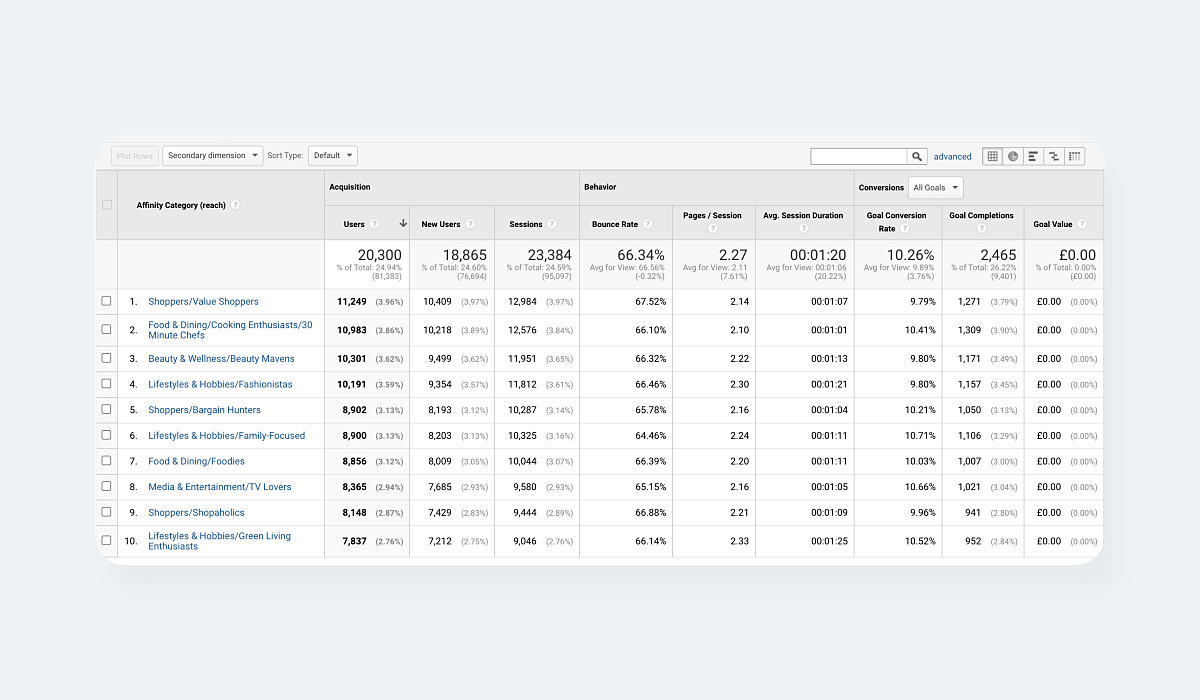
Investigate your social media presence next. You've probably already amassed a following. But who exactly are they? Fortunately, Facebook and Instagram provide Audience Insights insights to assist you in understanding your audience demographics. You can find out here:
Their age and gender distribution
Where are they?
Based on your follower activity, the optimal time to post
Finally, use the Traffic Analytics Audience Insights report to see how your audience compares to the competitors. Enter your domain and the domains of your biggest competitors to find out:
The size of each of your audiences
How much do your target audiences overlap?
Other websites that your target audience (or competitors) are likely to visit
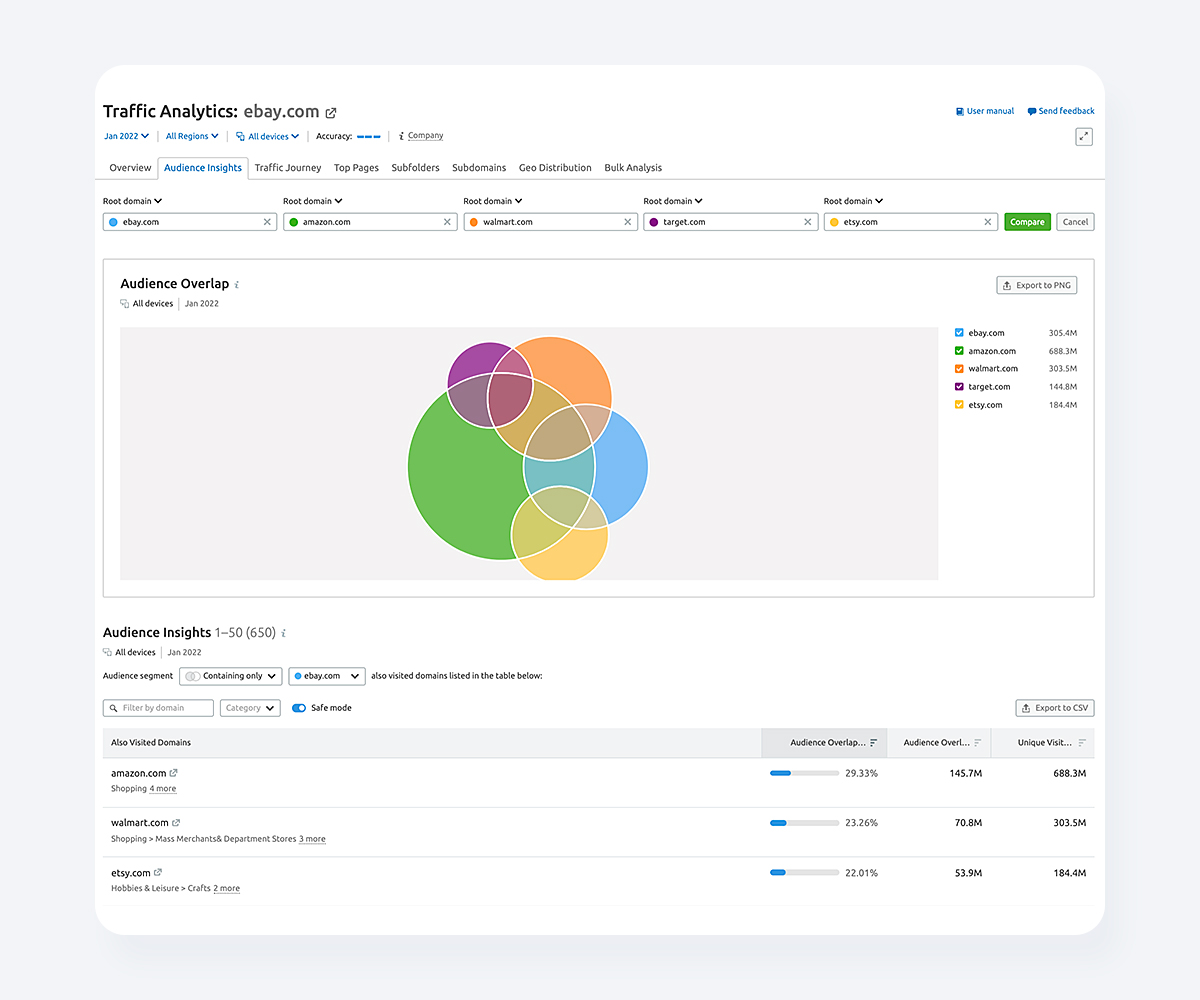
By combining all of this information, you'll have a more complete view of your target audience. Use what you've learned to develop material that is tailored to their specific requirements.
Maximising keyword research via topic clusters
Comprehensive keyword research is essential for the success of a blog. Create topic clusters to increase the impact of your keywords.
A topic cluster is a collection of blog posts that cover a specific topic in depth.
They usually revolve around a primary hub page that contains links to additional material.
Topic clusters allow you to target a variety of related, less competitive keywords to rank for a broader and more challenging umbrella term. They can provide several SEO benefits, including:
-
Increasing the exposure of your blog by making it easy for search engines to crawl
-
Increasing the authority of your blog on that topic over time
-
Allowing you to rank for more wide and more complex keywords
-
Interlinking allows more successful posts to promote less successful ones.
They also make use of Google's LSI (latent semantic indexing) technology.
But how does one go about creating a topic cluster?
First, decide on a pillar topic. Choose something relevant to your business in which you have extensive knowledge. The primary keyword for your hub pages should be pillar themes. Then you'll want to cover a few related sub-topics to back it up.
Not sure where to begin? Enter a topic you want to write about into the Keyword Magic Tool. Then, consider the search volume and Keyword Difficulty Score to determine which are the most effective.
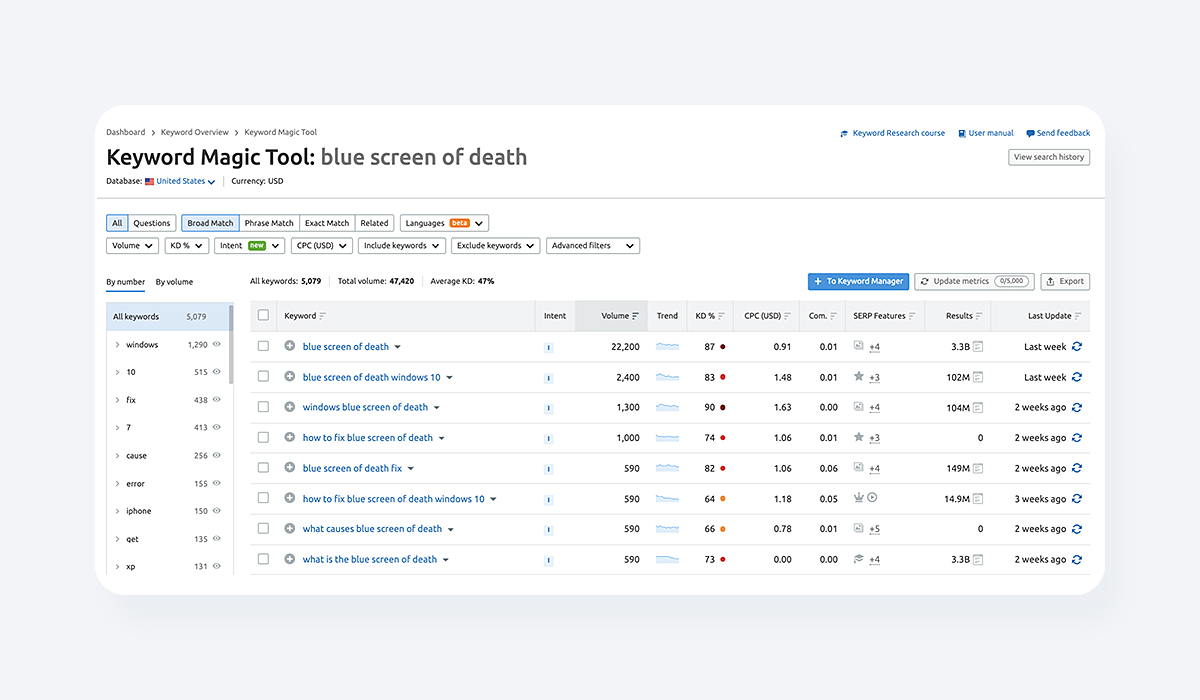
For the hub page of your topic cluster, use the broadest keyword. Then, for the individual pieces of content that hub sites link to, concentrate on more specialised keywords.
When you're ready, enter your keywords into the Topic Research Tool to create article ideas.
The Topic Research Tool can generate a plethora of content ideas, detect hot subjects, and organise them according to volume, difficulty, or efficiency (high volume, low difficulty ideas).
Fill out your cluster by adding fresh topic ideas to your content schedule. As you publish new articles, add them to your hub page so that readers (and search engines) can find them later.
Media, links, and a clear CTA
Long-form written material isn't the only technique to get out to your target audience. Engage your audience with rich material such as photographs, videos, audio, or bespoke infographics if you want your blog to stand out.
Rich media can also be used as a springboard to additional cluster material within the same pillar.
Not sure where to begin? Google offers a helpful guide on how to incorporate rich media into your work.
For a new blog article, video content is especially worthwhile. Videos keep users on a page for a set period, which can help keep your bounce rate low.

Video is another popular type of media, as evidenced by platforms such as TikTok and YouTube.
Even better, you can frequently repurpose blog content for videos, which simplifies the content development process.
However, enticing your visitors with valuable material is only half the battle. You'll need a strong internal linking strategy if you want to retain people on your site after they've done reading.
By incorporating connections to other sites in each post, you encourage visitors to explore your website further, which keeps them on your platform for a longer period. This can also assist search engines in locating additional relevant authority pages you provide.
Here are some pointers for creating more effective internal links:
-
Your anchor text should not contain more than five words.
-
Use your anchor text to inform the reader about what they can expect to find.
-
Make sure your links are not only related to your article but also beneficial to the reader.
SERPs for the win!
It's easy to overlook, but your blog post's opening is unlikely to be your reader's initial impression of the content. Instead, if they're visiting from an organic search, their initial impression will most likely be the appearance of your page in the SERPs.
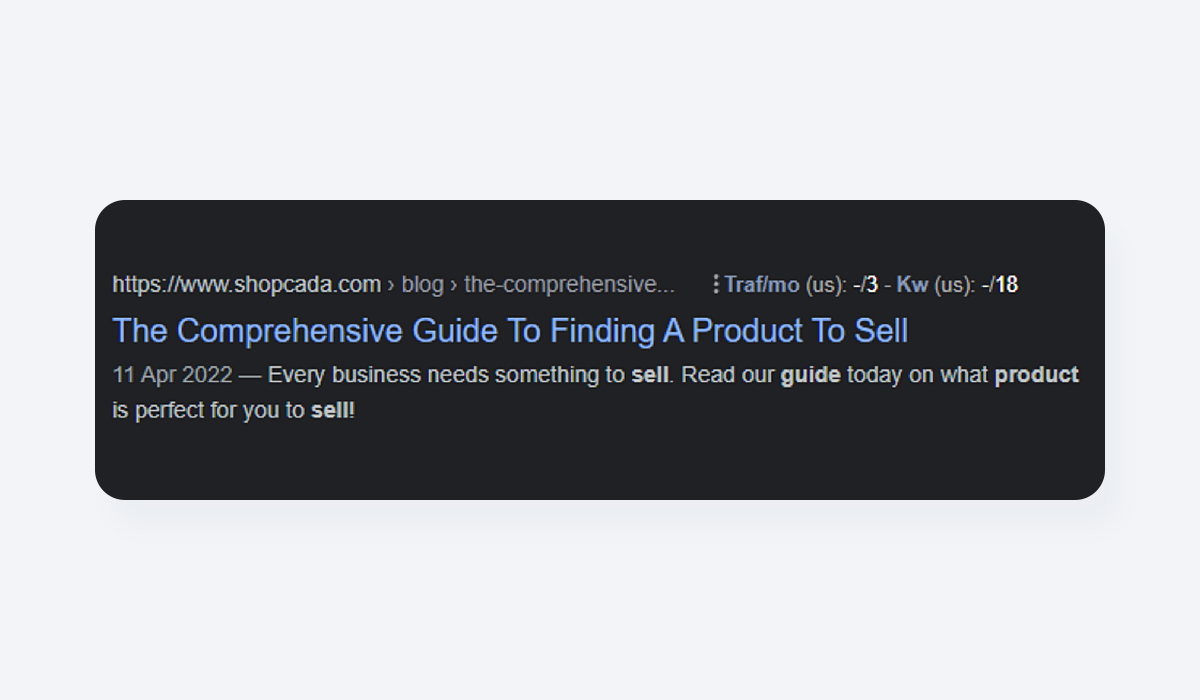
The truth is that you don't have perfect control over how your page appears in search results. However, you may boost it further by optimising your page title, meta description, and URL.
First, create an intriguing page title. Technically, you have two chances to title your article. The first of these is the page title. It is located in the HTML head element of your page, between the <title> tags. When you publish your post, it will display at the top of the browser window and on the search engine results pages (SERPs).
Here are some tips to help you write a better page title:
-
Keep it brief. On mobile, search results will show the first 50-60 characters before truncating.
-
Maintain accuracy. Your title should appropriately reflect the content of the page. To express the type of knowledge the reader will find, use terms like "how," "what," or "why," as well as solid descriptors.
-
Keep it distinct. It may be tempting to reuse the same title tag across your site, but this is detrimental to your SEO and readership. Instead, create a fresh title for each page.
Then, pay attention to the meta description. While meta descriptions may not have a direct impact on SEO, a well-written meta description can have a substantial impact on your click-through rate (CTR). In other words, this is your chance to persuade searchers to visit your page.
It's crucial to remember here that the meta description you submit may not always appear in search results. Google frequently rewrites meta descriptions to better match the user's search.
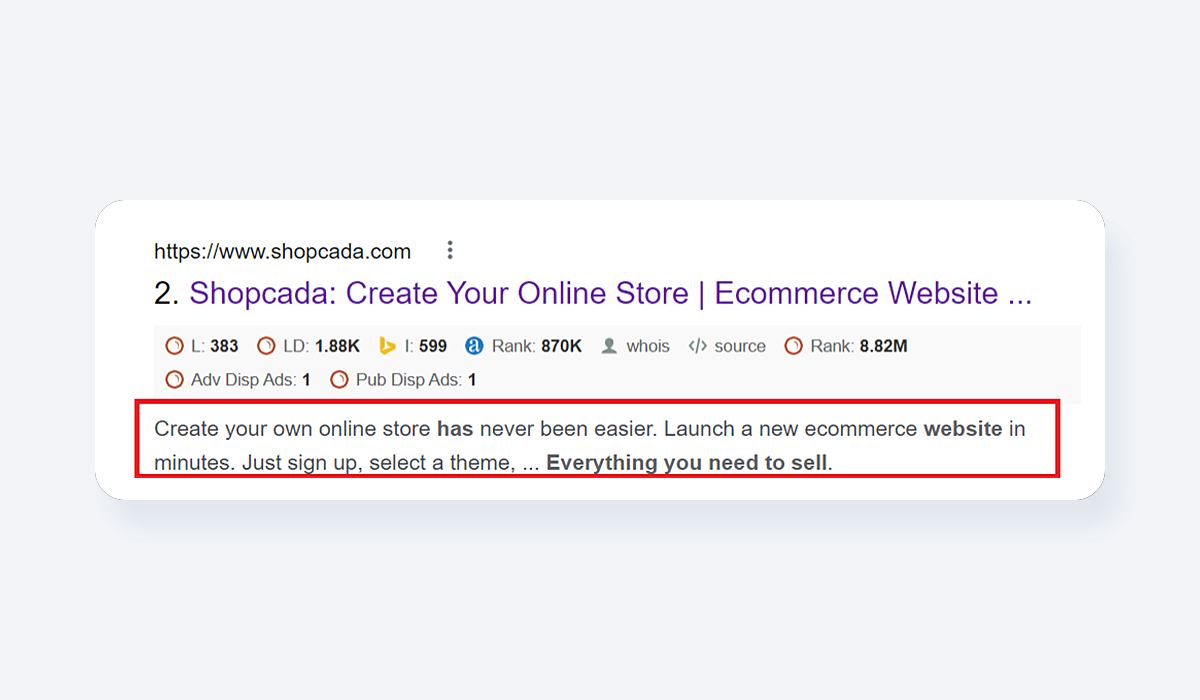
With that in mind, here are some pointers for creating effective meta descriptions:
-
Keep track of your character count. You have space for two sentences of up to 160 characters each.
-
Take care with your first sentences. When Google rewrites your meta description, it frequently takes the opening sentences of the relevant portion for that user's search.
-
Consider the competition. Try Googling for the terms you want to target and looking at how the pages that are currently ranking have written their snippets. Is there anything they have in common? Make use of everything you've learned to strengthen your description.
Finally, have a look at your website's URL. Put yourself in the shoes of your target audience. Would you be able to figure out what your page means based solely on the URL if you didn't have any additional context? If not, you should reconsider.
The protocol, domain name, top-level domain, and path are all part of your URL. The URL path will be the emphasis of this section.
An effective URL path should include the following elements:
-
Inform the reader about the topic of the page.
-
Show the reader exactly where they are on your website (e.g., on the blog or in another subfolder)
-
Include your primary keyword (if possible)
A captivating page title, meta description, and SEO-friendly URL can help you appear higher in search results and potentially enhance your CTR.
CMS or not to CMS?

Many content management systems (CMS) include plugins that might aid in the optimization of your blog. Even our Shopcada platform offers our proprietary CMS which can aid in your business blog writing all contained within your shop’s site itself.
Should you be running a WordPress site, on the other hand, Semrush's SEO Writing Assistant is quite a useful tool, which helps you enhance and optimise your content in real-time by making suggestions based on the top-ranking sites.
Yoast SEO is another famous WordPress plugin. When you install it, you get a module on each page's edit post that shows you how your page performs in key SEO parameters. It looks for everything from article length to inbound links, the meta title, focus keyword placement, and meta title size.
Overall, plugins can save you time with on-page SEO if you choose the ideal ones for you. However, using too many plugins can slow down your site and harm your SEO. So be selective, and only add tools and plugins that will enhance your workflow and the overall performance of your site.
Be mobile!

While you are not required to provide a mobile-friendly website, it is an important feature if you want to rank. Google has been using mobile-first indexing since 2019. This means that when indexing and ranking web pages, it prioritises the mobile version of the information over the desktop version.
The first step is to run your site via Google's mobile-friendly test tool to see if it is mobile-friendly. This will highlight some underlying difficulties and how to resolve them.
Consider adopting a responsive design instead of distinct URLs for mobile and desktop to optimise your site for mobile. This makes the material easier to distribute across devices, and backlinks to your blog aren't split across two URLs, increasing the value of these inbound links.
Here are a few basic stylistic measures you can do to make your mobile experience more user-friendly:
-
Avoid long blocks of text, which are difficult to read on mobile devices.
-
Make use of headers to divide your text into smaller chunks.
-
Avoid displaying content that is wider than the width of the screen.
-
Spread out your clickable elements to make them easier to interact with on small displays.
-
Use reader-friendly language and avoid narrow or difficult-to-read typefaces.
BONUS TIPS!
Headers
Headers assist Google's web crawlers in understanding your blog content and its sections.
Consider the crawlers to be readers who are skimming your content. Your H1 should provide a summary of what your article will discuss. The H2s, H3s, and H4s then break down the subtopics inside the essay.
As a result, your subheaders should reflect the body content and feature high-intent keywords. You have a far better chance of ranking on the SERP if you employ the correct keywords, which are those that your target audience is utilising.
Featured Snippets
Google's featured snippets are the most direct replies to search inquiries. For example, if I googled "How do you compose a blog post?" Google may display the best response using a featured snippet.
To get a featured snippet on Google, you must thoroughly and succinctly answer the question.
For example, if the search keyword is "how to run task manager," your H1 or H2 could be "How to Execute Task Manager on Windows PC," followed by the steps in a numbered or bulleted list.
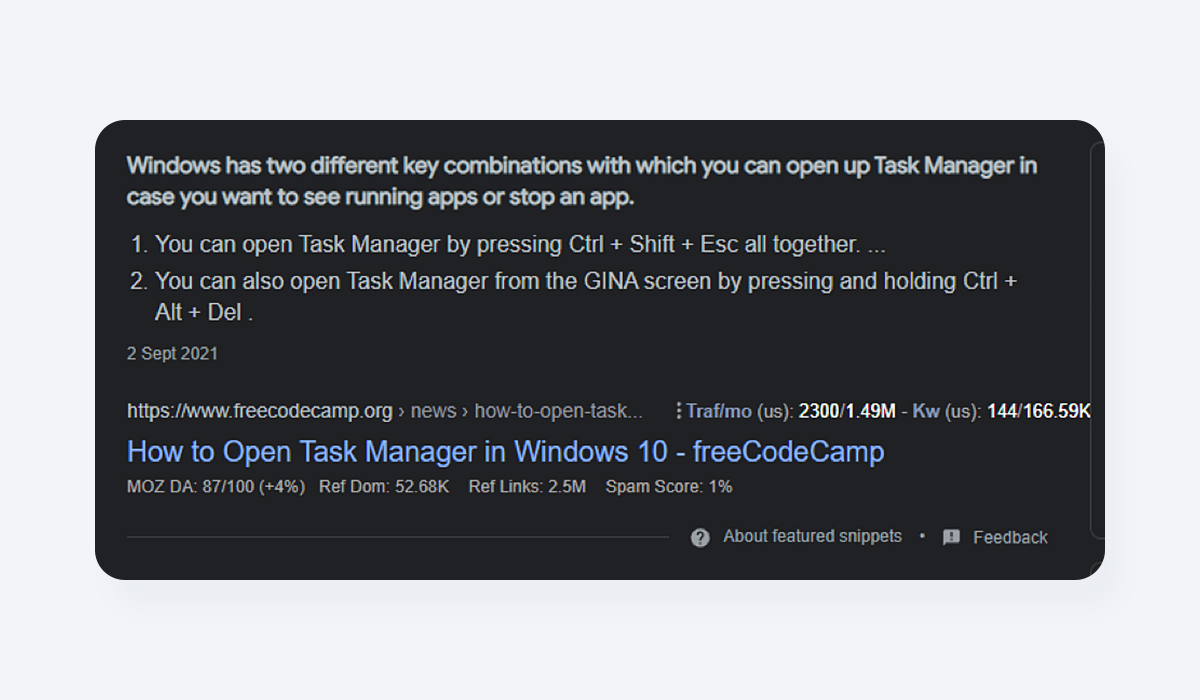
After then, make sure to incorporate a portion of the question in your response. Using the above example, you could begin the paragraph with: "Here's how to open Task Manager on your Windows..."
In addition, begin each sentence with an actionable verb, such as "click" or "choose."
If the term for which you wish to capture the featured snippet requires a definition, limit your response to 58 words.
By Humans For Humans
With all of these SEO standards, it's easy to lose sight of the fact that when a person searches on Google, they're seeking an answer. Writing high-quality blog content is the best method to boost your ranking prospects.
How does that appear? Comprehensive responses, scannable parts, well-organised subheaders, and visual aids
Keep in mind your buyer personas, as well as their motivations, challenges, and interests. It's also critical to identify topics that will appeal to your potential clients and answer their concerns.
Alt Text To Images
You should include alt text with any image you include in your post, whether it's a featured image or a body image.
Alt text indicates what is happening in the photo and aids Google (as well as others who are visually challenged) in understanding why the photo is included in your post.
Assume your article is about virtual events and you add the following image:

"Businessperson attending a virtual event sits at a desk" for example, could be the alt text.
This is a descriptive statement that incorporates the core term "virtual event." Even if this is a stock image, you can develop a narrative that corresponds to your blog post.
Keyword Research
Google is said to process around 70,000 search inquiries each second. Isn't that incredible?
If you want to rise above the SERP clutter and outrank your competition, you must target the particular keywords and phrases that your prospective clients are looking for. How else will people discover your content and website?
Begin by using a keyword research tool. Ahrefs and Google Keyword Planner, for example, provide information on what users are searching for and how popular certain searches are.
Google Trends may also show you which keywords are hot at any particular time. If you notice that searches for a given keyword are steadily diminishing over time, you realise it's probably not the correct keyword to target for your campaign. Rising tendencies, on the other hand, are the polar opposite.
If you ever run out of keyword ideas, go to your rivals for inspiration. Use competitive intelligence tools to determine which keywords their domains are now ranking for. Consider employing these keywords if they are relevant to your business.
Keep in mind, however, that the most obvious keywords may not always coincide with your plan. Furthermore, if trends move, language changes, or your product/service line expands, your focus keywords will evolve.
Conduct keyword research regularly to ensure you're still focusing on the proper keywords for your target audience and aren't missing out on important ranking possibilities.

Don’t go overboard with the keywords
The idea is to make your page highly optimised while being unobtrusive. Find natural keyword fits, but don't overdo it to the point where your material becomes unintelligible.
Avoid a meta description like this: "Sales for account-based marketing startups" if your keywords include "account-based marketing," "startups," and "sales."
Instead, to make the description more natural, try focusing on one or two keywords: "Are you seeking for game-changing tactics to improve your account-based marketing game? In this piece, you'll learn about our research-backed strategies."
You're still employing keywords in this technique, but you're not oversaturating the content. Remember that your purpose is to address a problem for your audience. If your users have a bad reading experience, Google will notice that your post isn't satisfying their needs.
Link Authority

Don't be scared to include external links while you write your blog content.
Linking to credible websites not only provides additional reading material for blog visitors to enhance their knowledge but also informs search engines that you've done your homework.
Nothing reinforces blog content like statistics from authoritative websites. Stats that are compelling assist you develop a more convincing and solid case that will help you acquire the trust of your audience.
Scannable, Longer Posts
In this day and age, you'd think that shorter blog entries are the way to go. In reality, search engines like Google prefer lengthier, in-depth blog posts.
Consider this: the more information on a page, the more hints search engines have to determine the topic of your site. HubSpot has discovered that the best length is between 2,100 and 2,400 words.
Longer blogs have the disadvantage of potentially overwhelming readers. One strategy is to divide your content into bite-sized, scannable portions.
Reduce big sentences to two and keep paragraphs to three phrases or less.
Don't overlook bullet points; they're excellent attention grabbers and easily digestible, especially on mobile devices.
Link Looping
Linking to other pages or blog posts on your website aids search engines in the creation of an accurate sitemap. It also assists your readers in discovering more of your material and getting to know you as a dependable source of information.
Internal links to other valuable content keep users on your site longer, minimising bounce rate and increase conversion potential. Isn't that what it all boils down to?
Use natural language for your anchor text when linking to any pages on your website or even other sources. Use generic or spammy calls to action, such as "top-rated inexpensive laptops" or "click here."
Instead, use descriptive keywords like "Download your SEO guide" to offer visitors a feel of what they will find when they click on the hyperlink.
Never force-feed links to your most popular pages, featured products, or sale items. Include links that complement the points made in your posts and are naturally related to the subject matter.
Image Compression

Google rewards pages that load quickly since it improves the user experience.
Large, heavy graphics is a major source of page latency. If you have multiple photographs in your article, each of which is larger than 100KB, this can have a significant influence on page speed.
Fortunately, there are free apps that compress photographs without sacrificing quality, such as Squoosh.app.
If you feel that slow page speeds are causing your low ranking, go to Google's PageSpeed site for a free examination and advice.
Link Building
Link building is essential for improving your search ranking.
Why? Consider search results to be a competition in which the victors receive the most votes. Each webpage that links back to you counts as a vote for your website, making your content more trustworthy in Google's eyes. As a result, you will move higher in the rankings.
As a result, it's a good idea to publish pieces that other websites or newspapers will want to link to on their own. Include high-value assets in your blog posts, such as original data and thought leadership, to make your website's blog entries more linkable.
Interviewing experts is another excellent technique to drive visitors back to your website.
Closing Words
The key to successful blog SEO is consistency. You must continuously write, optimise, and update search-focused blog entries. It takes effort, and rankings will not materialise quickly, but it is the only method to attract consistent search traffic to your blog.
If your blog is fresh and you lack 'authority,' it may be worth starting with low-competition, easier-to-rank keywords.
But, most importantly, don’t forget to love what you do while writing and slowly building out your blogs!

